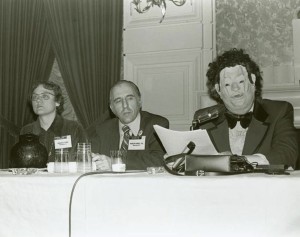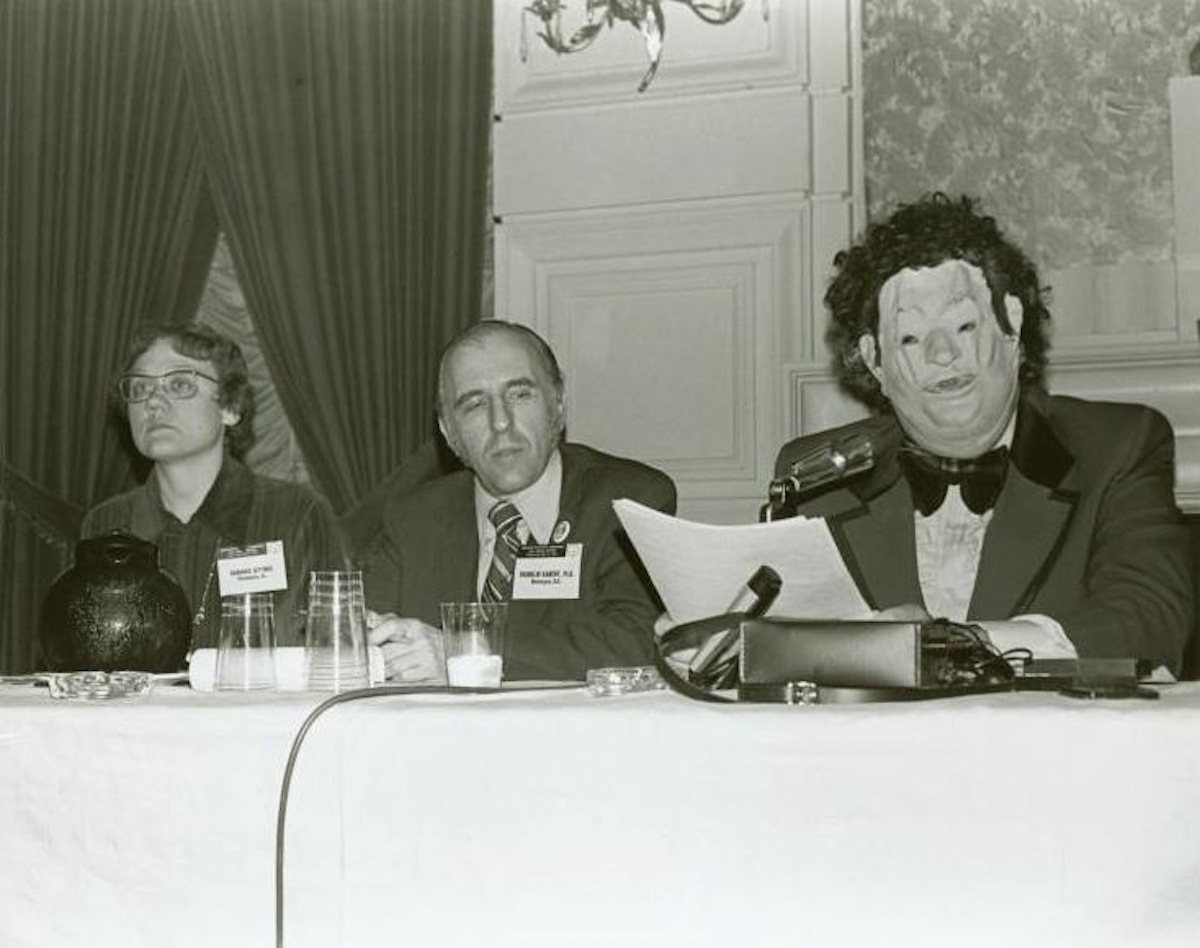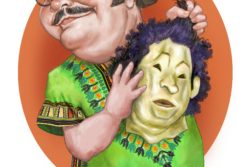IN 1952, the American Psychiatric Association published for the first time its official guide to mental illness, the Diagnostic and Statistical Manual, which quickly became the standard for the appraisal of mental illnesses of all kinds. This slim volume of 130 pages attempted to produce some standard naming conventions for psychiatrists across the U.S. Among the categories classed as mental illnesses were “truancy [and]stealing,” listed under “Transient Situational Personality Disorders.” Under “Sexual Deviation,” users of the manual were advised that “the diagnosis will specify the type of the pathological behavior, such as homosexuality, transvestism, pedophilia.”
In the second edition of the Diagnostic and Statistical Manual (DSM-II), published in 1968, the category of sexual deviations (§302) was broken into subcategories, and homosexuality was given its own diagnostic code (§302.0). This came under the heading: “V. Personality Disorder And Certain Other Non-Psychotic Mental Disorders.” This edition went through five printings between May 1968 and April 1973, and included “menopausal symptoms” and “malingering” in its roster of mental illnesses.

The tendency to pathologize same-sex attraction can be traced back to late 19th-century Germany,* where psychiatry itself was born and where a medical model of mental health came to be applied to all manner of personality variables. Freud presented his evolving perspectives in Three Essays on the Theory of Sexuality starting in 1905 and continuing with expanded and updated editions until 1925. He used the relatively neutral word “inversion” to refer to same-sex sexual desires and activities, stating that there are facts “which make it impossible to regard inversion as a sign of degeneracy.” He also wrote a compassionate letter to the mother of a presumably gay man (Bayer, 1987): “Homosexuality is assuredly no advantage, but it is nothing to be ashamed of, no vice, no degradation, it cannot be classified as an illness.”
For all his avoidance of loaded language when describing inversion, Freud did classify it as a pathological condition, so it was an easy matter for subsequent psychiatrists to turn it into a more-or-less severe form of mental illness. Starting in the 1950’s and 60’s, many psychiatrists in the U.S., working against the backdrop of McCarthyism and the general prudery of the times, adopted theories of homosexuality as an acquired condition—a result of poor parenting, weak or absent fathers, overbearing mothers, etc.—that could be re-oriented through psychoanalysis or other methods.
Some psychiatrists built their careers on treating homosexuals using various techniques, such as shock treatment, depth psychology, and aversion therapy. Two of the most zealous proponents of the pathology model were Irving Bieber and Charles Socarides. Both men accepted and sought to expand upon Freud’s notion of homosexuality as environmentally determined in men, making intensive use of the family dynamic involving a domineering mother and a distant father. Socarides hypothesized that the deviant adaptation occurred during the first two years or “Oedipal Stage” of a male infant’s development, with the upshot that the boy fails to separate from the mother and accept the father as a role model. (In a twist of fate, or perhaps poetic justice, Charles Socarides’ son Richard would eventually come out as openly gay—and use his father’s infamy to become a national activist for gay rights.)
Gittings, Lahusen, and the Psychiatric Establishment
Such was the state of American psychiatry when an early GLBT activist was just coming of age. Barbara Gittings was twenty years old when the first DSM was published in 1952. At that point she had already been reading about homosexuality for a few years. One reference had led to another, and eventually she followed the thread from Philadelphia to San Francisco and found the Daughters of Bilitis, an information organization for lesbians. A few years later, in 1958, the San Francisco leaders of the DOB, Del Martin and Phyllis Lyon, invited Gittings to start up an East Coast chapter, and the New York DOB was born. Gittings was a devoted reader of The Ladder, the little magazine that was the voice of the DOB, and in 1962 she went to work for The Ladder, first as its corresponding secretary and, starting in 1963, as its editor (where she remained until 1966). At the suggestion of her partner Kay Tobin Lahusen, she added the subtitle “A Lesbian Review” to the magazine. Lahusen joined her in devising the covers and helping edit in myriad ways, effectively becoming the first lesbian photojournalist. Together they built a subscription base on the East Coast.
Commenting on the absence of progress in advancing gay and lesbian equality, Gittings posited that “the overriding problem was invisibility. How do you organize people that you can’t see?” It was one of the marked differences between the gay civil rights movement and the African-American movement. In the documentary film Before Stonewall, Gittings points out that skin color identified a recognizable minority, while lesbians were hidden even from one another. Even the word “gay” was not in general use but was instead a code word used by the cognoscenti to identify one another.
While editing The Ladder, Gittings supported herself with clerical work and dove into activism. She was one of the few women who were willing to identify themselves by their real name in print. She didn’t think that anyone would piece together her movement persona and her work life, and it appears that she was right. She was also willing to be photographed and identified by name. In 1966, she was fired as editor of The Ladder ostensibly for being late with some editions, but also for having adopted a more militant stance than her West Coast counterparts in DOB. Pleading mea culpa to both charges, she decided to turn her attention to an area where she felt she could do some good. She was aware of some test cases challenging the government’s ban on civil service employment, military service, and security clearances for gay citizens, and soon found Frank Kameny, who was spearheading many of these efforts. Gittings became co-counsel with Kameny in these legal efforts, which included testifying together against Charles Socarides before the Department of Defense, which was holding hearings on whether homosexual DOD employees should be fired.
The late Frank Kameny, who held a doctorate in astronomy from Harvard, had in 1957 been fired from his job in the federal government (at an agency that was the precursor to NASA) when evidence of his homosexuality had surfaced. After a lengthy appeal process, he learned that the Supreme Court would not hear his case. He then applied his prodigious intelligence to fighting back on several fronts. He organized the first gay group dedicated exclusively to the political struggle for gay and lesbian rights, the Mattachine Society of Washington, and later, in 1965, organized the first public demonstrations in support of homosexual rights.
Lahusen and Kameny don’t remember exactly where they met, but it was at some conference in 1963 or ’64, possibly that of the East Coast Homophile Organization. It was Lahusen who first heard Kameny speak, informing Gittings that “You have to hear this guy.” They were impressed by Kameny’s view that the time was past for secret meetings and underground publications that made no dent in public awareness of the concerns of homosexual citizens.
It was also Lahusen who, years later, noticed that a panel was planned for the 1972 APA convention to address the topic of homosexuality, but that no gay psychiatrist or other practitioner was on the panel. This was three years after Stonewall, the movement had now gone very public indeed, and this absence stood out as a glaring omission. Lahusen urged Gittings to try to change this. With the blessings of the organizer of the event, Gittings got on the phone, wrote letters, and finally found just one gay psychiatrist who agreed to appear on the panel as “Dr. H. Anonymous.” He insisted that he would appear only if he could be in disguise. He wore a full-face rubber mask, a wig, and a tuxedo three sizes too large, and he used a voice distortion microphone.
As it happens, Gittings knew a number of gay psychiatrists who had trusted her enough to come out to her in the early 70’s; she even dubbed herself the “fairy godmother” of this psychiatric vanguard. They held get-togethers offsite from the official APA meetings and called themselves the GayPA. When Lahusen suggested trying to find a gay psychiatrist for the June 1972 APA panel, Gittings had a ready list of names to call. As Lahusen’s photograph of the panel reveals, the eventual lineup included Gittings and Kameny, neither a psychiatrist but both appearing as themselves, and psychiatrist John E. Fryer in disguise. A photo of Dr. H. Anonymous made the front cover of the newspaper Gay News Weekly with the caption “Shrinks Asked to Join Gay Liberation. American Psychiatric Ass’n Told: We’ll Fight Those Who Oppose Us. ” Another photograph on the same front page showed Gittings in front of the exhibit booth with a sign proclaiming in large letters, “gay, proud and healthy.”
Kameny was opposed to having anyone appear in a mask. Lahusen would later quote Kameny as saying, “This goes against everything we’ve been fighting for,” adding: “So we had a terrific argument with Frank. People thought we were just rubber-stamps for Frank but that wasn’t true—because we were all so strong-minded. It was a big struggle but we prevailed and we got Dr. H. Anonymous on the panel.” Dr. H. Anonymous’ panel attracted an overflow crowd of psychiatrists, what with its provocative title, “Psychiatry: Friend or Foe to Homosexuals?” Dr. Anonymous spoke openly about what it was like to be homosexual in a field that defined him as pathological, and about the fear of being discovered and losing his practice.
It would be years before the speaker identified himself as John Fryer, M.D. Other gay psychiatrists who had been invited to be on the panel regretfully and apologetically declined, fearing the loss of their licenses, loss of referrals, loss of friends. Gittings read excerpts of letters from those who felt they couldn’t appear.
Lahusen helped design and assemble exhibits at the 1972 convention and at the following two. “Gay, Proud and Healthy: The Homosexual Community Speaks,” read the sign in the huge APA exhibit hall. It caught the attention of psychiatrists, who engaged in conversations with Gittings while Lahusen photographed the encounters. In a 2009 interview, she recalled: “One psychiatrist looked at these pictures of loving couples and said, ‘Does this really work for you people?’ The psychiatrists were mostly dumbfounded and their stereotypical views were really shattered in a way.” Once the APA voted to axe the DSM designation of homosexuality as a mental illness, displays promoting GLBT issues and causes became a fixture in APA exhibit halls. One year’s theme was “Homophobia: Time for Cure”; the slogan in 1978 was “Gay Love: Good Medicine.”
In 1972, the same year as this panel, Lahusen published a book called The Gay Crusaders. The publisher preferred to have a man’s name on the cover of the book, so Randy Wicker lent his name, but Lahusen, with Gittings’ help, actually wrote the book. Together, Gittings and Lahusen brought attention to the gay cause and helped move the spotlight from accounts by psychiatrists of patients’ problems to the real life stories of gay people in the cause and in the larger gay community. The pair spoke with passion and energy. There is a conversational interview of them in Eric Marcus’ book, Making Gay History. They appear as a tag team, touching down lightly and handing the baton back and forth easily.
The APA Retreats
By 1973, the APA had been under pressure for two years. In 1970, gay activists had disrupted their conference in San Francisco. In 1971, there was both a gay panel at the Washington, D.C., meeting and an organized disruption of the prestigious Convocation of Fellows. Reported Kameny in a 2010 interview: “There had been a meeting that had been organized that involved the Gay Liberation Front and the newly formed Gay Activists Alliance and the Mattachine Society of Washington. They planned operating together to invade the convocation.” Despite efforts by the APA to keep protesters out, “A number of people got in. The person who was preselected to present to the psychiatrists was pushed out the door. I marched up to the stage and seized the microphone, the moderator said, ‘What are you doing?’ ‘I’m seizing the microphone from you.’ I denounced them, saying, ‘Psychiatry is the enemy incarnate. … You may take this as a declaration of war against you.’” Although the moderator retrieved the microphone, the agitprop continued. Kameny and another gay activist said that they wanted to “present their demands for the deletion of homosexuality from the APA’s official nosology, DSM II, to members of the Association on Nomenclature.”
Although that presentation did not take place, the panel with the masked psychiatrist at the 1972 meeting in Dallas made a huge impression. At APA meetings over the next year and a half, Gittings, Lahusen, and Kameny pressed their case for change in various ways and settings, even while they were occupied with other aspects of the gay movement. Lahusen took photographs, including one showing a group of gay activists carrying a sign that read, “We are the Experts on Homosexuality.” Inevitably, more activists, psychiatrists, and others joined in the struggle. Ron Gold, Director of Communication for the newly minted National Gay Task Force (later the Gay & Lesbian and Task Force) delivered a provocative talk titled, “Stop it. You’re Making Me Sick!”
Then, in May of 1973, at a secret meeting, Kameny, Ron Gold, Charles Silverstein, and the editor of the DSM, Robert Spitzer, drafted two resolutions, one condemning discrimination against gay people and the other calling for the APA to drop the entry in the DSM labeling homosexuality as an illness. Finally, in December 1973, the APA board of trustees passed these two resolutions, effectively removing homosexuality as an illness from the DSM. Press releases went out and the press took notice far and wide. The headline “Twenty Million Homosexuals Gain Instant Cure” hit at least one major newspaper (Marcus, 2002). Irving Bieber and Charles Socarides were outraged and called for a referendum, asking all members of the APA to vote on the issue. A vote was taken, and the resolution to declassify was carried by 58 to 37 percent. After that, gay and lesbian psychiatrists gradually began forming openly gay groups in the late 70’s.
It would be 1980 before the next printing of the DSM. From a slim volume in 1952 it had grown to hundreds of pages and included whole new categories of mental illness. Gay activists knew they had won a major victory when “homosexuality” did not appear in the new edition. Today, mental health professionals encourage acceptance of GLBT people while repudiating therapies designed to change people’s sexual orientation.
On October 7, 2005, at the APA’s fifty-eighth Institute on Psychiatric Services, Gittings accepted the APA’s first John E. Fryer, M.D., award, which recognizes individuals who have “made significant contributions to LGBT mental health.” Frank Kameny shared in the award, which was given jointly to the two activists. A write-up and photo appeared in the APA’s official newspaper, Psychiatric News (issue 41.21, 2006), with the headline “Activists Forced Psychiatrists to Look Behind Closet Door.”
Today, Lahusen continues the work, putting together a photographic history of the early days of gay activism for the New York Public Library. The APA continues to evolve. In a 2007 statement from the speaker of the assembly (of the APA), Michael Blumenfield, M.D., wrote: “More recent position statements passed by the Assembly and Board of Trustees after much debate include those supporting legal recognition of same-sex unions (2004) and same-sex civil marriage (2005), issues that continue to reverberate throughout our society.” Barbara Gittings, whose final years were filled with commendations for her work as an activist, died in 2007. (A lengthy obituary can be found in these pages in the May-June 2007 issue.)
* Of course, the deepest origins of homosexuality as an illness can be traced to religious sources. Early Christian traditions saw procreation as the sole purpose of sex. As Ronald Bayer remarked in Homosexuality and American Psychiatry (1987): “religious abhorrence of homosexual practice was carried over into the secular law. … It was against this background of moral opprobrium that the scientific study of homosexuality began.”
References
Bayer, Ronald. Homosexuality and American Psychiatry: The Politics of Diagnosis. Princeton Univ. Press, 1987.
Bullough, Vern L. Before Stonewall: Activists for Gay and Lesbian Rights in Historical Context. Harrington Park Press, 2002.
Drescher, Jack and Joseph P. Merlino, eds. American Psychiatry and Homosexuality: An Oral History. Harrington Park Press, 2007.
Marcus, Eric. Making Gay History: The Half-Century Fight for Lesbian and Gay Equal Rights. Perennial, 2002.
Tobin, Kay and Randy Wicker. The Gay Crusaders. Arno Press, 1975.
Margaret Rubick, MA, investigates and writes on topics related to health advocacy, including ethics, health care law, and illness narratives.





